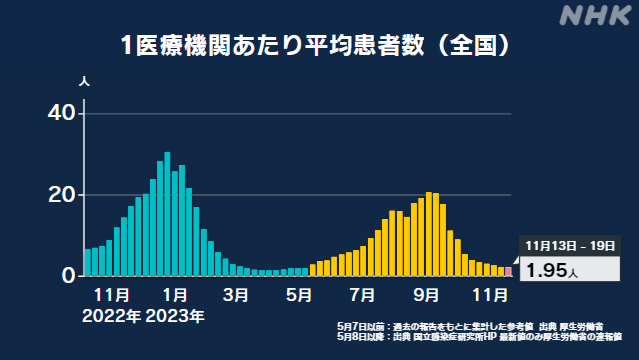The average number of patients per medical institution in the week to November 11 is 19.1, which is 1.95 times higher than the previous week. The Ministry of Health, Labour and Welfare said, "Although the number of patients continues to decrease after the transition to Category 0, we hope that measures will continue in the future because winter is the time when infections spread."
According to the Ministry of Health, Labor and Welfare, the number of new corona patients reported by about 11,19 medical institutions nationwide in the week to November 1 decreased by 5000 from the previous week to 293,9648.
In addition, the average number of patients per medical institution was 1.95, which was 0.97 times higher than the previous week.
This is the 11th consecutive week of decline from the previous week.
By prefecture, in descending order
, ▽ Hokkaido has 5.98 people, Nagano Prefecture has 4.97 people, Akita Prefecture has 3.12 people, Gifu Prefecture has 2.77 people, Yamanashi Prefecture has 2.76 people
, etc. It decreased in 28 prefectures from the previous week.
In the week ending November 11, 19 new hospitalizations were reported from about 1 medical institutions nationwide, a decrease of 500 from the previous week.
The Ministry of Health, Labor and Welfare has said that "the number of patients continues to decline, and although it was the lowest this week, it is expected that measures will continue in the future because infections tend to spread in winter every year."
Average number of patients per medical institution (by prefecture)
▽ Hokkaido 5.98 people ▽ Nagano Prefecture 4.97 people ▽ Akita Prefecture 3.12 people ▽ Gifu Prefecture 2.77 people ▽ Yamanashi Prefecture 2.76 people ▽ Toyama Prefecture 2.71 people ▽ Yamagata Prefecture 2.58 people ▽ Aomori Prefecture 2.47 people
▽ Ishikawa Prefecture 2.42 people ▽ Aichi Prefecture 2.37 people ▽ Fukushima Prefecture 2.34 people ▽ Kagawa Prefecture 2.34 people ▽ Tochigi Prefecture 2.33 people ▽ Gunma Prefecture 2.22 people ▽ Yamaguchi Prefecture 2.16 people
▽ Niigata Prefecture 2.16 people ▽ Iwate Prefecture 2.1 people ▽ Ehime Prefecture 2.05 people ▽ Nara Prefecture 1.91 people ▽ Ibaraki Prefecture 1.89 people ▽ Chiba Prefecture 1.76 people ▽ Tokushima Prefecture 1.73 people
▽ Hiroshima Prefecture 1.72 people ▽ Saitama Prefecture 1.67 people ▽ Tottori Prefecture 1.66 people ▽ Miyagi Prefecture 1.65 people ▽ Kumamoto Prefecture 1.65 people ▽ Nagasaki Prefecture 1.64 people ▽ Saga Prefecture 1.62 people
▽ Kyoto Prefecture 1.61 people ▽ Hyogo Prefecture 1.61 people ▽ Shizuoka Prefecture 1.6 people ▽ Fukui Prefecture 1.59 people ▽ Shiga Prefecture 1.57 people ▽ Okayama Prefecture 1.55 people ▽ Wakayama Prefecture 1.51 people
▽ Okinawa Prefecture 1.44 people ▽ Osaka Prefecture 1.41 people ▽ Fukuoka Prefecture 1.3 people ▽ Kagoshima Prefecture 1.28 people ▽ Miyazaki Prefecture 1.26 people ▽ Kanagawa Prefecture 1.24 people ▽ Kochi Prefecture 1.2 people
▽ Tokyo has 1.17 people ▽ Oita Prefecture has 1.16 people ▽ Mie Prefecture has 1.14 people ▽ Shimane Prefecture has 1.03 people
Experts: "We can never be optimistic"
Dr. Nao Ishida, Deputy Director of Kurashiki Central Hospital, commented on the epidemic situation of the new coronavirus, saying, "Although it is quite small, it will not disappear completely, and there are predictions that the next wave of the epidemic will come in the future, so we cannot be optimistic."

